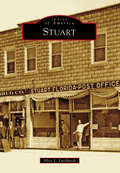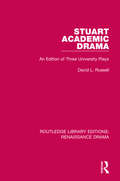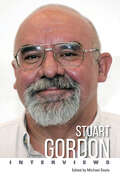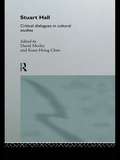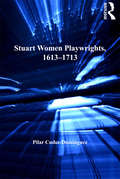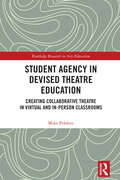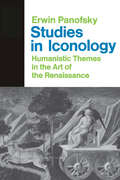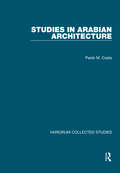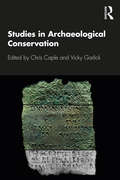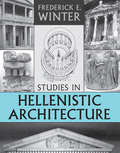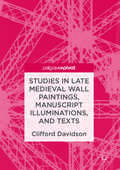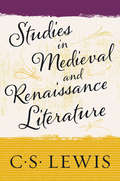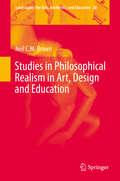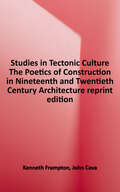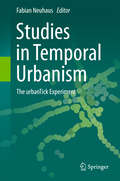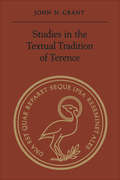- Table View
- List View
Stuart (Images of America)
by Alice L. LuckhardtOn the southeast coast of Florida in the 1880s, a quaint little community was nestled along the tranquil waters of the St. Lucie River in a wilderness of tropical beauty, one of the region's last frontiers. As lucrative pineapple crops and the commercial fishing industry began to flourish, trade boats brought necessary supplies, and new settlers arrived on river steamers. With land available for homesteading or for sale at $1.25 an acre, the small village soon to be known as Stuart would become a mecca for innovative, hardworking young men seeking business and financial opportunities. By the dawn of the 20th century, the railroad had been established, and the town, forged by the fortitude of early pioneers, thrived, eventually becoming a beautiful, friendly incorporated city.
Stuart Academic Drama: An Edition of Three University Plays (Routledge Library Editions: Renaissance Drama)
by David L. RussellAlthough not much is known about the three Stuart plays in this edition, which was first published in 1987, we can ascribe them to one of the English universities, and each is indicative of a distinctly different influence on the Renaissance academic drama. Heteroclitanomalonomia is part of a minor subgenre referred to as the academic play. It demonstrates the predominance of language or rhetoric studies in the period and its very subject is of purely academic interest. Gigantomachia displays the continuing interest of the Renaissance in classical mythology. And A Christmas Messe follows a more homely tradition, a farcical personification of the mundane. This title will be of interest to students of English Literature, Drama and Performance.
Stuart Gordon: Interviews (Conversations with Filmmakers Series)
by Michael DoyleAnimated by a singularly subversive spirit, the fiendishly intelligent works of Stuart Gordon (1947–2020) are distinguished by their arrant boldness and scab-picking wit. Provocative gems such as Re-Animator, From Beyond, Dolls, The Pit and the Pendulum, and Dagon consolidated his fearsome reputation as one of the masters of the contemporary horror film, bringing an unfamiliar archness, political complexity, and critical respect to a genre so often bereft of these virtues. A versatile filmmaker, one who resolutely refused to mellow with age, Gordon proved equally adept at crafting pointed science fiction (Robot Jox, Fortress, Space Truckers), sweet-tempered fantasy (The Wonderful Ice Cream Suit), and nihilistic thrillers (King of the Ants, Edmond, Stuck), customarily scrubbing the sharply drawn lines between exploitation and arthouse cinema.The first collection of interviews ever to be published on the director, Stuart Gordon: Interviews contains thirty-six articles spanning a period of fifty years. Bountiful in anecdote and information, these candid conversations chronicle the trajectory of a fascinating career—one that courted controversy from its very beginning. Among the topics Gordon discusses are his youth and early influences, his founding of Chicago’s legendary Organic Theatre (where he collaborated with such luminaries as Ray Bradbury, Kurt Vonnegut, and David Mamet), and his transition into filmmaking where he created a body of work that injected fresh blood into several ailing staples of American cinema. He also reveals details of his working methods, his steadfast relationships with frequent collaborators, his great love for the works of Lovecraft and Poe, and how horror stories can masquerade as sociopolitical commentaries.
Stuart Hall: Critical Dialogues in Cultural Studies
by Kuan-Hsing Chen David MorleyStuart Hall's work has been central to the formation and development of cultural studies as an international discipline. Stuart Hall: Critical Dialogues in Cultural Studies is an invaluable collection of writings by and about Stuart Hall. The book provides a representative selection of Hall's enormously influential writings on cultural studies and its concerns: the relationship with Marxism; postmodernism and 'New Times' in cultural and political thought; the development of cultural studies as an international and postcolonial phenomenon, and Hall's engagement with urgent and abiding questions of 'race', ethnicity and identity.In addition to presenting classic writings by Hall and new interviews with Hall in dialogue with Kuan-Hsing Chen, the collection, which includes work by Angela McRobbie, Kobena Mercer, John Fiske, Charlotte Brunsdon, Ien Ang and Isaac Julien, provides a detailed analysis of Hall's work and his contribution to the development of cultural studies by leading cultural critics and cultural practitioners. The book also includes a comprehensive bibliography of Stuart Hall's writings.
Stuart Women Playwrights, 1613–1713
by Pilar Cuder-DominguezIn the field of seventeenth-century English drama, women participated not only as spectators or readers, but more and more as patronesses, as playwrights, and later on as actresses and even as managers. This study examines English women writers' tragedies and tragicomedies in the seventeenth century, specifically between 1613 and 1713, which represent the publication dates of the first original tragedy (Elizabeth Cary's The Tragedy of Mariam) and the last one (Anne Finch's Aristomenes) written by a Stuart woman playwright. Through this one-hundred year period, major changes in dramatic form and ideology are traced in women's tragedies and tragicomedies. In examining the whole of the century from a gender perspective, this project breaks away from conventional approaches to the subject, which tend to establish an unbridgeable gap between the early Stuart period and the Restoration. All in all, this study represents a major overhaul of current theories of the evolution of English drama as well as offering an unprecedented reconstruction of the genealogy of seventeenth-century English women playwrights.
Stud: Architectures of Masculinity (Routledge Revivals)
by Joel SandersOriginally published in 1996, Stud: Architectures of Masculinity is an interdisciplinary exploration of the active role architecture plays in the construction of male identity. Architects, artists, and theorists investigate how sexuality is constituted through the organization of materials, objects, and human subjects in actual space. This collection of essays and visual projects critically analyzes the spaces that we habitually take for granted but that quietly participates in the manufacturing of "maleness." Employing a variety of critical perspectives (feminism, "queer theory," deconstruction, and psychoanalysis), Stud's contributors reveal how masculinity, always an unstable construct, is coded in our environment. Stud also addresses the relationship between architecture and gay male sexuality, illustrating the resourceful ways that gay men have appropriated and reordered everyday public domains, from streets to sex clubs, in the formation of gay social space.
Student Agency in Devised Theatre Education: Creating Collaborative Theatre in Virtual and In-Person Classrooms (Routledge Research in Arts Education)
by Mike PobleteThis monograph argues that implementing devised theatre as a learning praxis has a unique potential to cultivate student agency in the twenty-first century classroom. It offers actionable guidance for drama instructors by providing a new arts education methodology that emphasizes the role of student-led dramaturgy. Based on quantitative and qualitative analyses of survey results, group interviews, and field observations from the facilitation of two original pieces of digital devised theatre created by Pacific Islander and Asian-American public high school students on Oʻahu, the author documents the crucial roles of constructive and resisting student agency in a devised theatre classroom. This book then departs from established research in suggesting that passivity serves a crucial role in allowing students to assert agency nonconfrontationally, which has considerable implications for peripatetic learners. It also investigates the role of student agency in online theatre education, which, along with expected challenges, was found to produce unique benefits, such as real-time documented performance feedback and accessible asynchronous teacher guidance. Further, a new form of student agency is identified, one exclusive to online learning environments, where students assert themselves by discussing technological challenges such as slow Wi-Fi, camera malfunctions, or other pragmatic concerns. Finally, this book makes a case that the success of these projects with Pacific Islander and Asian-American students suggests that although devising comes from a White Eurocentric tradition, it can provide an effective learning strategy for students from a wide variety of backgrounds.As global discourse continues to push toward reform that would allow populations around the world increased agency over their lives, this volume makes a unique contribution to the critical conversation around student agency in education today and will appeal to scholars and researchers across arts education, and theatre and performance studies.
Studies In Iconology: Humanistic Themes In The Art Of The Renaissance
by Erwin PanofskyIn Studies in Iconology, the themes and concepts of Renaissance art are analysed and related to both classical and medieval tendencies.
Studies in Arabian Architecture (Variorum Collected Studies)
by Paolo M. CostaBased on extensive architectural and archaeological research, these papers present a series of studies on the art, buildings, settlement patterns, and land use in Iraq, Yemen and Oman, from the pre-Islamic period to modern times. Many of the monuments and sites were studied here for the first time, and have subsequently disappeared or become inaccessible. Among the main themes emerging from Professor Costa’s work are the continuity of Arab craftsmanship, in both technical and aesthetic terms, from Late Antiquity into the Islamic period; the relationship between the natural and the built environment; and the dependence of architecture and settlement patterns on the exploitation of natural resources, especially water.
Studies in Archaeological Conservation
by Chris Caple Vicky GarlickStudies in Archaeological Conservation features a range of case studies that explore the techniques and approaches used in current conservation practice around the world and, taken together, provide a picture of present practice in some of the world-leading museums and heritage organisations. Archaeological excavations produce thousands of corroded and degraded fragments of metal, ceramic, and organic material that are transformed by archaeological conservators into the beautiful and informative objects that fill the cases of museums. The knowledge and expertise required to undertake this transformation is demonstrated within this book in a series of 26 fascinating case studies in archaeological conservation and artefact investigation, undertaken in laboratories around the world. These case studies are contextualised by a detailed introductory chapter, which explores the challenges presented by researching and conserving archaeological artefacts and details how the case studies illustrate the current state of the subject. Studies in Archaeological Conservation is the first book for over a quarter of a century to show the range and diversity of archaeological conservation, in this case through a series of case studies. As a result, the book will be of great interest to practising conservators, conservation students, and archaeologists around the world.
Studies in Hellenistic Architecture
by Janos Fedak Frederick E. WinterStudies in Hellenistic Architecture is a detailed analysis of the development of the major building-types of the Hellenistic age - the mid-fourth century B.C. to the time of the Roman conquest of the Eastern Mediterranean. In this meticulous work, Frederick E. Winter reveals how the architects of the period went beyond anything achieved by their Classical Greek predecessors, and how these impressive skills prepared the way for many of Rome's later architectural achievements.Geographically, the monuments included in this volume extend from Spain to Afghanistan and from Provence to North Africa. Winter discusses the architectural achievements of the various regional styles of the Eastern Mediterranean, and takes a detailed look at Hellenistic developments west of the Adriatic.While the interrelationship of these regional developments is often unclear, especially in cases where there are no explicit criteria for dating, Winter makes excellent use of the advance in scholarship over the past fifty to sixty years, offering the first real attempt at a synthesis of this vast subject. Studies in Hellenistic Architecture is an invaluable resource, containing a wealth of illustrations of the various types of Hellenistic building and the most comprehensive scholarship to date on the topic.
Studies in Late Medieval Wall Paintings, Manuscript Illuminations, and Texts
by Clifford DavidsonThis volume is an interdisciplinary consideration of late medieval art and texts, falling into two parts: first, the iconography and context of the great Doom wall painting over the tower arch at Holy Trinity Church, Coventry, and second, Carthusian studies treating fragmentary wall paintings in the Carthusian monastery near Coventry; the devotional images in the Carthusian Miscellany; and meditation for "simple souls" in the Carthusian Nicholas Love's Mirror of the Blessed Life of Jesus Christ. Emphasis is on such aspects as memory, participative theology, devotional images, meditative practice, and techniques of constructing patterns of sacred imagery.
Studies in Medieval and Renaissance Literature
by C. S. LewisThis entertaining and learned volume contains book reviews, lectures, and hard to find articles from the late C. S. Lewis, whose constant aim was to show the twentieth-century reader how to read and understand old books and manuscripts. Highlighting works by Spenser, Dante, Malory, Tasso, and Milton, Lewis provides a refreshing update to medieval and Renaissance criticism, and equips modern readers to understand these works in a new way.
Studies in Medieval and Renaissance Literature
by C. S. LewisThis entertaining and learned volume contains book reviews, lectures, and hard to find articles from the late C. S. Lewis, whose constant aim was to show the twentieth-century reader how to read and understand old books and manuscripts. Highlighting works by Spenser, Dante, Malory, Tasso, and Milton, Lewis provides a refreshing update to medieval and Renaissance criticism, and equips modern readers to understand these works in a new way.
Studies in Medieval and Renaissance Literature
by C. S. LewisThis entertaining and learned volume contains book reviews, lectures, and hard to find articles from the late C. S. Lewis, whose constant aim was to show the twentieth-century reader how to read and understand old books and manuscripts. Highlighting works by Spenser, Dante, Malory, Tasso, and Milton, Lewis provides a refreshing update to medieval and Renaissance criticism, and equips modern readers to understand these works in a new way.
Studies in Perspective (Dover Architecture)
by Jan Vredeman de VriesWhen the Renaissance reached Northern Europe, Jan Vredeman de Vries (1527-1604) ranked among its most influential advocates. His books of architectural engravings opened new avenues of invention, reflecting the era's artistic crosscurrents. Their combination of Northern and Southern elements forms a powerful expression of sixteenth-century Netherlands culture and constitutes a new style that spread throughout Germany, Scandinavia, and the British Isles.This book, the last and greatest of Vredeman's works, perpetuated not only the Renaissance interest in perspective but also the important work done by Dürer, from whom Vredeman acquired much of his knowledge. These engravings include exteriors of architectural structures, Gothic interiors, gardens, medieval townscapes, and views into domes or vaults and down many-tiered stairwells. More than 70 plates offer a fascinating collection for any art lover.
Studies in Philosophical Realism in Art, Design and Education
by Neil C. M. BrownThis book fills a gap in the literature of 21st century international visual arts education by providing a structured approach to understanding the benefits of Philosophical Realism in art education, an approach that has received little international attention until now. The framework as presented provides a powerful interface between research and practical reconceptualisations of critical issues and practice in the domains of art, design, and education that involve implications for curriculum in visual arts, teaching and learning, cognitive development, and creativity. The book extends understanding of Philosophical Realism in its practical application to teaching practice in visual arts in the way it relates to the fields of art, design, and education. Researchers, teacher educators and specialist art teachers are informed about how Philosophical Realism provides insights into art, design, and education. These insights vary from clearer knowledge about art to the examination of beliefs and assumptions about the art object. Readers learn how cognitive reflection, and social and practical reasoning in the classroom help cultivate students' artistic performances, and understand how constraints function in students' reasoning at different ages/stages of education.
Studies in Tectonic Culture: The Poetics of Construction In Nineteenth and Twentieth Century Architecture
by Kenneth FramptonComposed of ten essays and an epilogue that trace the history of contemporary form as an evolving poetic of structure and construction, the book's analytical framework rests on Frampton's close readings of key French and German, and English sources from the eighteenth century to the present. Kenneth Frampton's long-awaited follow-up to his classic A Critical History of Modern Architecture is certain to influence any future debate on the evolution of modern architecture. Studies in Tectonic Culture is nothing less than a rethinking of the entire modern architectural tradition. <p><p>The notion of tectonics as employed by Frampton-the focus on architecture as a constructional craft-constitutes a direct challenge to current mainstream thinking on the artistic limits of postmodernism, and suggests a convincing alternative. Indeed, Frampton argues, modern architecture is invariably as much about structure and construction as it is about space and abstract form. Composed of ten essays and an epilogue that trace the history of contemporary form as an evolving poetic of structure and construction, the book's analytical framework rests on Frampton's close readings of key French and German, and English sources from the eighteenth century to the present. He clarifies the various turns that structural engineering and tectonic imagination have taken in the work of such architects as Perret, Wright, Kahn, Scarpa, and Mies, and shows how both constructional form and material character were integral to an evolving architectural expression of their work. <p><p>Frampton also demonstrates that how these elements are articulated from one work to the next provides a basis upon which to evaluate the works as a whole. This is especially evident in his consideration of the work of Perret, Mies, and Kahn and the continuities in their thought and attitudes that linked them to the past. Frampton considers the conscious cultivation of the tectonic tradition in architecture as an essential element in the future development of architectural form, casting a critical new light on the entire issue of modernity and on the place of much work that has passed as "avant-garde." A co-publication of the Graham Foundation for Advanced Studies and The MIT Press.
Studies in Temporal Urbanism
by Fabian NeuhausThis book is very much about what the name urbanTick literally says, about the ticking of the urban, the urban as we experience it everyday on the bus, in the park or between buildings. It is about the big orchestrated mass migration of commuters, the seasonal blossoms of the trees along the walkway and the frequency of the stamping rubbish-eater-trucks. It is also, not to forget, about climate, infrastructure, opening hours, term times, parking meters, time tables, growing shadows and moon light. But most of all it is about how all this is experienced by citizens on a daily basis and how they navigate within this complex structure of patterns. The content of this book is based on the content of the urbanTick blog between 2008-2010. One year blogging about this topic brought together a large collection of different aspects and thoughts. It is not at all a conclusive view, the opposite might be the case, it is an exploratory work in progress, while trying to capture as many facets of the topic as possible.
Studies in Words
by C. S. LewisLanguage--in its communicative and playful functions, its literary formations and its shifting meanings--is a perennially fascinating topic. C. S. Lewis's Studies in Words explores this fascination by taking a series of words and teasing out their connotations using examples from a vast range of English literature, recovering lost meanings and analyzing their functions. It doubles as an absorbing and entertaining study of verbal communication, its pleasures and problems. The issues revealed are essential to all who read and communicate thoughtfully, and are handled here by a masterful exponent and analyst of the English language.
Studies in Words
by C. S. LewisLanguage--in its communicative and playful functions, its literary formations and its shifting meanings--is a perennially fascinating topic. C. S. Lewis's Studies in Words explores this fascination by taking a series of words and teasing out their connotations using examples from a vast range of English literature, recovering lost meanings and analyzing their functions. It doubles as an absorbing and entertaining study of verbal communication, its pleasures and problems. The issues revealed are essential to all who read and communicate thoughtfully, and are handled here by a masterful exponent and analyst of the English language.
Studies in Words
by C. S. LewisLanguage--in its communicative and playful functions, its literary formations and its shifting meanings--is a perennially fascinating topic. C. S. Lewis's Studies in Words explores this fascination by taking a series of words and teasing out their connotations using examples from a vast range of English literature, recovering lost meanings and analyzing their functions. It doubles as an absorbing and entertaining study of verbal communication, its pleasures and problems. The issues revealed are essential to all who read and communicate thoughtfully, and are handled here by a masterful exponent and analyst of the English language.
Studies in Words
by C. S. LewisLanguage--in its communicative and playful functions, its literary formations and its shifting meanings--is a perennially fascinating topic. C. S. Lewis's Studies in Words explores this fascination by taking a series of words and teasing out their connotations using examples from a vast range of English literature, recovering lost meanings and analyzing their functions. It doubles as an absorbing and entertaining study of verbal communication, its pleasures and problems. The issues revealed are essential to all who read and communicate thoughtfully, and are handled here by a masterful exponent and analyst of the English language.
Studies in the Social and Cultural History of Modern Warfare: British Art and the First World War, 1914–1924
by James FoxThe First World War is usually believed to have had a catastrophic effect on British art, killing artists and movements, and creating a mood of belligerent philistinism around the nation. In this book, however, James Fox paints a very different picture of artistic life in wartime Britain. Drawing on a wide range of sources, he examines the cultural activities of largely forgotten individuals and institutions, as well as the press and the government, in order to shed new light on art's unusual role in a nation at war. He argues that the conflict's artistic consequences, though initially disruptive, were ultimately and enduringly productive. He reveals how the war effort helped forge a much closer relationship between the British public and their art - a relationship that informed the country's cultural agenda well into the 1920s.
Studies in the Textual Tradition of Terence
by John N. GrantThe textual tradition of the Latin dramatist Publius Terentius Afer (second century BC) is unusually rich and complex. Over six hundred manuscripts containing some or all of Terence's six comedies have survived, but only one codex and three small fragments date from antiquity. All the rest were copied in the Middle Ages and the Renaissance when Terence was very popular. Recently scholars have been devoting considerable study to the role of his works and the commentaries on them in the cultural and intellectual development of the Middle Ages and the Renaissance. However, little attention has been given to an examination and re-examination of the manuscripts in order to determine which are the most useful for establishing a reliable text of the plays. In this study John N. Grant examines afresh the manuscript tradition of the comedies, looking in particular at a branch of the medieval manuscripts which has been neglected in the past. He establishes the primacy of one manuscript, the value of which has hitherto been disputed, and points out the importance of others which have been known but have been neglected by past editors of Terence. In addition, through a careful study of the cycle of illustrations that appear in some medieval manuscripts he brings under scrutiny the history of the transmission of the text in late antiquity. He shows that, contrary to the generally held view, the date of the original cycle of illustrations from which those in the medieval manuscripts are derived cannot be used to provide a chronological keystone for the lost ancient manuscripts which were the ancestors of the surviving witnesses. An appendix with a selection of readings from over 150 manuscripts will be of value to those interested in investigating further the relationships among the extant manuscripts. This study lays the foundation for a new edition of the plays of Terence.
